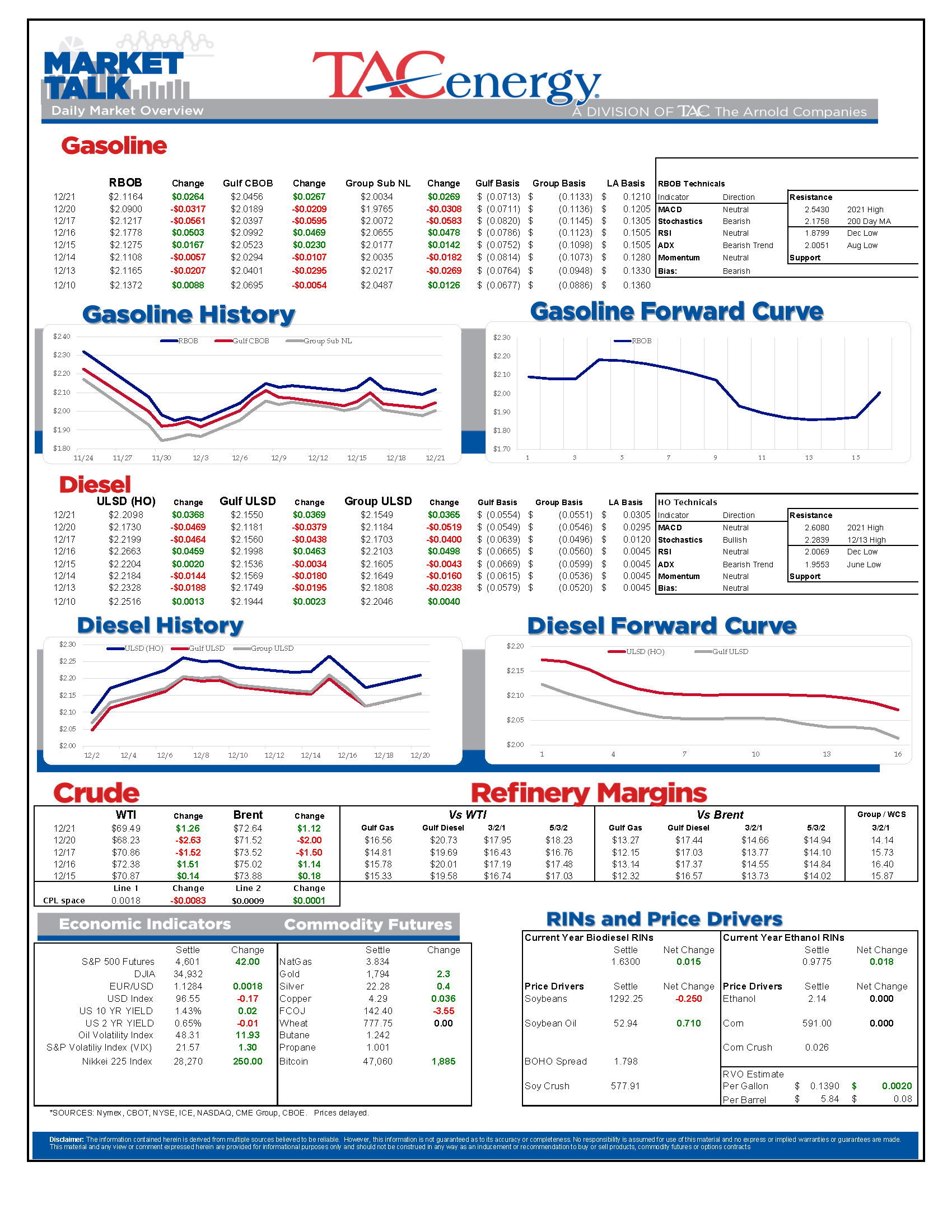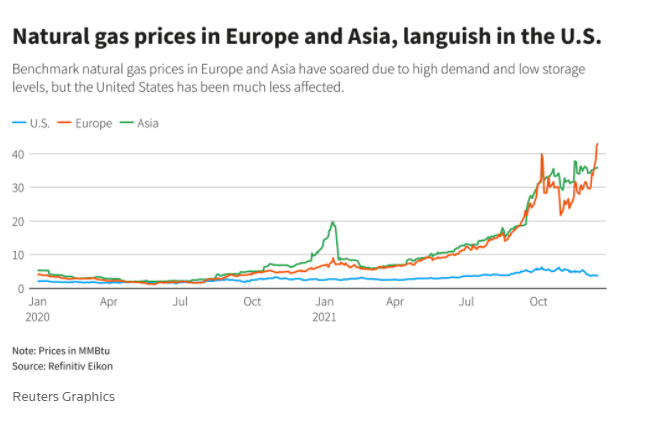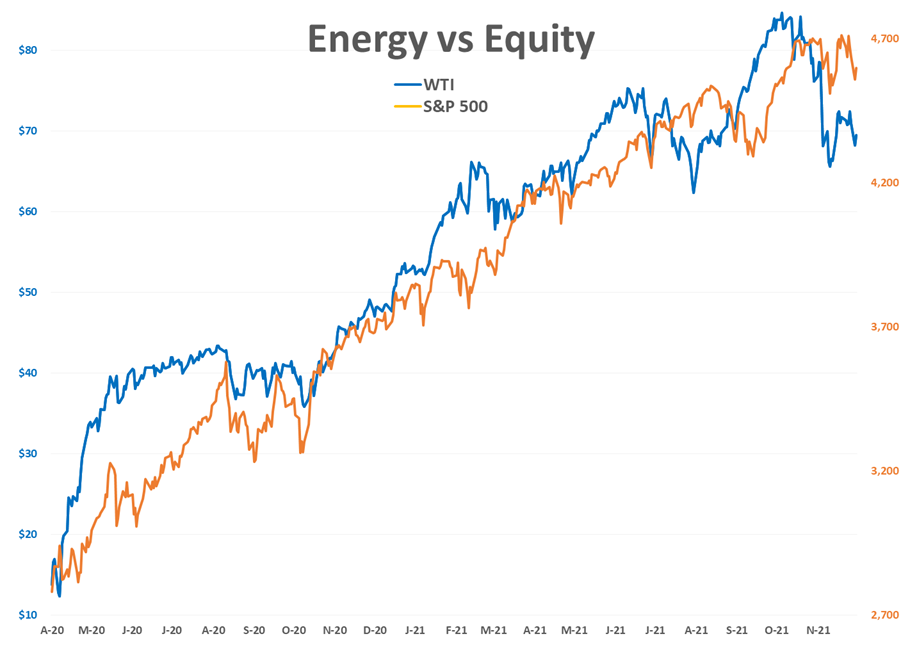Supply Issues Seem To Have Put The Omicron Demand Fears On The Back Burner Temporarily

Oil prices have bounced nearly $4/barrel, and refined products by a dime since Monday’s lows as a combination of supply issues seem to have put the Omicron demand fears on the back burner temporarily.
Part of the bounce is being blamed on Libya declaring force majeure on its oil exports Monday as several of the country’s largest fields were closed by militants ahead of the country’s election, which may or may not happen this week. OPEC has already been struggling to meet its output quotas, compared to pre-COVID when it struggled to keep its members from over-producing, and these shutdowns will only make that issue worse.
European natural gas prices are also soaring this week as cold weather arrives just in time for Russia to remind the world of its supply power by reversing flows on a pipeline that supplies Germany. While the supply crunch in Europe and Asia were often blamed for propelling oil and diesel prices higher earlier in the year, the Reuters chart below shows that US natural gas prices haven’t flinched during this latest price spike, which could be a reflection that LNG exports from the US simply can’t move fast enough to supplement during these winter weather events.
Stock markets are also rallying after 3 days of heavy selling, with plenty of guesses as to why, but little in the way of actual news to support the sudden turnaround. That begs the question for the rest of the week, is this a short term correction or the end of the Omicron fear selloff? For energy contracts, look to the trend lines once again for the answer, with the weekly charts showing that RBOB needs to climb above $2.15 and ULSD above $2.25 to consider this move anything more than a dead cat bounce.
The EPA announced its new fuel economy standards for passenger vehicles Monday, which it called the most ambitious ever, and would require average an increase from the 2020 record of 25.4mpg to 40mpg by 2026. The plan focuses on model years 2023-2026, and estimates that electric vehicles will need to increase from 7% of the new vehicles produced in 2023 to 17% in 2026, on top of new technology in gasoline engines, in order to reach the standard.
Meanwhile, it looks like the EPA will get another chance to shut down the refinery formerly known as Hovensa, as a new auction has resulted in yet another company planning to attempt to restart the twice bankrupt facility.
Click here to download a PDF of today's TACenergy Market Talk.
News & Views
View All
Crude Oil, Gasoline, And Diesel Benchmarks Are All Trading >1% Lower To Start The Day
Energy prices are sinking again this morning, albeit with a little more conviction than yesterday’s lackadaisical wilting. Crude oil, gasoline, and diesel benchmarks are all trading >1% lower to start the day with headlines pointing to an across-the-board build in national inventories as the source for this morning’s bearish sentiment. The Department of Energy’s official report is due out at its regular time this morning (9:30am CDT).
WTI has broken below its 100-day moving average this morning as it fleshed out the downward trend that began early last month. While crossing this technical threshold may not be significant in and of itself (it happened multiple times back in February), the fact that it coincides with the weekly and monthly charts also breaking below a handful of their respective moving averages paints a pretty bearish picture in the short term. The door is open for prices to drop down to $75 per barrel in the next couple weeks.
Shortly after the EIA’s weekly data showed U.S. commercial crude inventories surpassing 2023 levels for the first time this year, their monthly short-term energy outlook is forecasting a fall back to the bottom end of the 5-year range by August due to increasing refinery runs over the period. However, afterward the administration expects a rise in inventories into 2025, citing continued production increases and loosening global markets hindering the incentive to send those excess barrels overseas. The agency also cut back their average gas and diesel price forecasts for the first time since February with the biggest reductions in the second and third quarter of this year.
The STEO also featured their famed price prediction for WTI, stating with 95% confidence that the price for crude oil will be between $40 and $140 through 2026.
Need a general indication of the global crude oil supply? Most headlines seem to be covering a shortage of a different type of oil, one that we haven’t turned into fuel (yet).
Click here to download a PDF of today's TACenergy Market Talk.

The Perceived Cooling Of Regional Tensions In The Middle East Area Attributing To The Quiet Start To Today’s Trading Session
The energy complex is drifting lower this morning with RBOB futures outpacing its counterparts, trading -.9% lower so far to start the day. The oils (WTI, Brent, heating) are down only .2%-.3% so far this morning.
The perceived cooling of regional tensions in the Middle East area attributing to the quiet start to today’s trading session, despite Israel’s seizure of an important border crossing. A ceasefire/hostage-release agreement was proposed Monday, and accepted by Hamas, but rejected by Israel as they seemingly pushed ahead with their Rafah offensive.
U.S. oil and natural gas production both hit record highs in 2023 and continue to rise in 2024, with oil output currently standing at 13.12 million barrels per day and January 2024 natural gas production slightly exceeding the previous year. With WTI currently changing hands at higher than year-ago levels, this increased production trend is expected to continue despite a decrease in rigs drilling for these resources.
Less than a week after the Senate Budget Committee’s hearing centered on the credibility of big oil’s climate preservation efforts, a major oil company was reported to have sold millions of carbon capture credits, without capturing any carbon. Fraud surrounding government subsidies to push climate-conscious fuel initiatives is nothing new, on a small scale, but it will be interesting to see how much (if any) of the book is thrown at a major refiner.
Today’s interesting read: sourcing hydrogen for refining.
Click here to download a PDF of today's TACenergy Market Talk.

Energy Contracts Are Trying To Find A Floor After Taking Their Largest Weekly Losses Of The Year So Far Last Week
Energy contracts are trying to find a floor after taking their largest weekly losses of the year so far last week.
There’s not much in the way of news yet this morning, so the modest buying is largely being blamed on reports that Saudi Arabia raised its prices for Asian and Mediterranean buyers in June, signaling that demand is strong enough in those markets to shoulder the increase.
RBOB gasoline futures have already dropped 28 cents from the high set April 12th, leading the argument that prices have peaked for the season. The 200-day moving average comes in just under $2.50/gallon this week, some 6.5 cents below current values, and helps set a pivotal chart support layer. If prices break there, there’s a strong case that we’ll see another 20-30 cents of downside, similar to what we saw this time last year.
Money managers continued to reduce their net length in NYMEX contracts last week, as WTI, RBOB and ULSD saw a net decrease of more than 17,000 contracts of speculative length. The hedge fund liquidation seems to have run its course for this latest news cycle however, as new short positions accounted for the majority of the decrease, and WTI and Brent both saw new length added by the big speculators. Money managers are now net-short on ULSD, which could be another reason to think the bottom is near if you subscribe to the theory that the bandwagon-jumping hedge funds usually are wrong.
Baker Hughes reported a decline of 7 oil rigs and 3 natural gas rigs last week, bringing the combined total rig count to its lowest level in more than 2 years. Perhaps most noteworthy in this week’s report was that Alaska saw 5 of its 14 active rigs taken offline in just 1 week. It’s not yet clear if this may have anything to do with the startup of the transmountain pipeline which will have Western Canadian crude now competing more directly with Alaskan grades.
Click here to download a PDF of today's TACenergy Market Talk.



